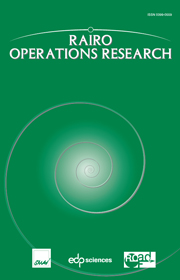No CrossRef data available.
Article contents
On finding optimal parameters of an oscillatory model ofhandwriting
Published online by Cambridge University Press: 11 July 2014
Abstract
In this paper, we show how optimization methods can be used efficiently to determine theparameters of an oscillatory model of handwriting. Because these methods have to be usedin real-time applications, this involves that the optimization problems must be rapidelysolved. Hence, we developed an original heuristic algorithm, named FHA. This code wasvalidated by comparing it (accuracy/CPU-times) with a multistart method based on TrustRegion Reflective algorithm.
Information
- Type
- Research Article
- Information
- Copyright
- © EDP Sciences, ROADEF, SMAI 2014
References
G. André, www.irit.fr/∼Gaetan.Andre/publications.php.
Coleman, T.F. and Li, Y., An interior trust region approach for nonlinear minimization subject to bounds. SIAM J. Opt. 6 (1993) 418–445. Google Scholar
Coleman, T.F. and Li, Y., On the convergence of interior-reflective Newton methods for nonlinear minimization subject to bounds. Math. Program. 67 (1994) 189–224. Google Scholar
E. Gilet, Modélisation bayésienne d’une boucle de perception action : Application al’écriture (Bayesian Modelisation of a sensori-motor loop: application to reading and handwriting). Thesis, Joseph, Fourier University, Grenoble, France (2009).
Hollerbach, J.M., An oscillatory theory of handwriting. Biol. Cybern. 156 (1981) 139–156. Google Scholar
Longcamp, M. et al., The imprint of action: motor cortex involvement in visual perception of handwritten letters. NeuroImage 23 (2006) 681–688. Google Scholar
Plamondon, R. et al., Modelling velocity profiles of rapid movements: a comparative study. Biol. Cybern. 69 (1993) 119–128. Google ScholarPubMed
Plamondon, R., On-Line and Off-Line, Handwriting Recognition: A Comprehensive Survey. IEEE Trans. Pattern Anal. Mach. Intell. 22 (2000) 63–84. Google Scholar
Plötz, T. and Fink, G., Markov models for offline handwriting recognition: a survey. Int. J. Doc. Anal. Recogn. (IJDAR) 12 (2009) 169–298. Google Scholar
Viviani, P. and Flash, T., Minimum-jerk, two-thirds power law, and isochrony: converging approaches to movement planning. J. Exp. Psychol. Hum. Percept. Perform. 21 (1995) 32–53. Google ScholarPubMed

